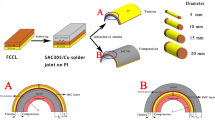Abstract
This study investigated the effects of solid-state aging on Sn–3Ag–0.5Cu (SAC305) and Sn–9Zn (SZ) solder joints with two Cu electroplated layers: PC-Cu and PCS-Cu. Distinct surface features and impurity levels were evident in PC-Cu and PCS-Cu owing to the use of different additives in the electroplating solutions. The SAC305 solder joints exhibited notable voids and cracks at the joint interface during aging, which were attributed to the high impurity content of PC-Cu. In contrast, low-impurity PCS-Cu did not exhibit void formation. Regardless of whether PC-Cu or PCS-Cu was used, no interfacial voids were observed in the SZ solder joints, implying that the SZ solder effectively suppressed voids. Mechanisms related to void suppression were also proposed. The presence of Zn in the solder changed the interfacial reactions, forming a Cu5Zn8 intermetallic compound (IMC) in addition to the Cu–Sn IMCs in the SAC305 solder joints. Inhibited grain-boundary diffusion in high-impurity scenarios hinders voids owing to the effective substitution of Cu vacancies by Zn. With Zn consumption near the soldering interface, the Cu5Zn8 IMC detached and a Cu6Sn5 phase was formed between the Cu–Zn IMC and Cu. Meanwhile, PCS-Cu exhibited localized Cu6Sn5 growth. In addition, SZ showed less influence of Cu impurities on the interfacial IMC thickness compared to SAC/PC-Cu with rapid IMC growth. The findings revealed the void formation mechanisms and highlighted the void-suppressing features of SZ in solder joints.







Similar content being viewed by others
Data availability
Data will be made available on reasonable request.
References
Y. Liu, N. Tu, Mater. Today Adv. 8, 100115 (2020)
J.H. Huang, P.S. Shih, V. Renganathan, S.J. Grӓfner, Y.A. Chen, C.H. Huang, C.L. Kao, Y.S. Lin, Y.C. Hung, C.R. Kao, Electrochim. Acta 425, 140710 (2022)
Y. Liu, Y. Lu, K.N. Tu, Mater. Sci. Eng. R Rep. 151, 100701 (2022)
K.S. Huang, T.H. Shen, W. Liu, J.L. Chao, T. Wu, Mater. Chem. Phys. 272, 124966 (2021)
K.R. Hebert, J. Electrochem. Soc. 152, C283 (2005)
H. Lee, T.-Y. Yu, H.-K. Cheng, K.-C. Liu, P.-F. Chan, W.-P. Dow, C.M. Chen, J. Electrochem. Soc. 164, D457 (2017)
Y.J. Kao, Y.J. Li, Y.A. Shen, C.M. Chen, Sci. Rep. 13, 1 (2023)
Z. Zheng, P.C. Chiang, P. Feng, Microelectron. Reliab. 99, 44 (2019)
P.C. Chiang, Y.A. Shen, C.M. Chen, J. Mater. Sci. Mater. Electron. (2021). https://doi.org/10.1016/j.jmrt.2022.07.140
P.-F. Chan, H. Lee, S.I. Wen, M.C. Hung, C.M. Chen, ACS Appl. Electron. Mater. 2, 464 (2020)
H.Y. Hsiao, C.M. Liu, H. Lin, T.C. Liu, C.L. Lu, Y.S. Huang, Science 36, 1007 (2012)
J.-Y. Lee, Y.-A. Shen, C.-M. Chen, Sci. Technol. Weld. Join. (2023). https://doi.org/10.1016/j.jmrt.2023.06.034
C.E. Ho, S.C. Yang, R. Kao, Lead-Free Electronic Solders (Springer, Berlin, 2007)
P.-C. Chiang, Y.-A. Shen, C.-M. Chen, J. Mater. Sci. Mater. Electron. 32, 11944 (2021)
F. Gao, H. Nishikawa, T. Takemoto, Electron. Mater. 37, 45 (2008)
J.Y. Wang, C.F. Lin, C.M. Chen, Scr. Mater. 64, 633 (2011)
Y. Hirata, C.H. Yang, S.K. Lin, H. Nishikawa, Mater. Sci. Eng. A 813, 141131 (2021)
W.H. Lin, A.T. Wu, S.Z. Lin, T.H. Chuang, K.N. Tu, J. Electron. Mater. 36, 753 (2007)
M.J. Willey, A.C. West, J. Electrochem. Soc. 154, D156 (2007)
C.C. Chen, C.H. Yang, Y.S. Wu, C.E. Ho, Surf. Coat. Technol. 320, 489 (2017)
F. Wang, D. Li, J. Wang, X. Wang, C. Dong, J. Mater. Sci. Mater. Electron. 28, 1631 (2017)
Acknowledgements
We appreciate the support for the Ultra HR SEM at the National Yang Ming Chiao Tung University Instrument Resource Center (EM002800) under Project MOST 111-2731-M-A49-001.
Funding
Yu-An Shen thanks the National Science and Technology Council for Project 112-2221-E-035-022. Chih-Ming Chen would like to thank the National Science and Technology Council for Project 110-2221-E-005-006-MY3.
Author information
Authors and Affiliations
Contributions
YA Shen: validation, formal analysis, investigation, data curation, writing—original draft, writing—review & editing, project administration, funding acquisition, supervision, and project administration. C-Y Lin: validation, formal analysis, investigation, data curation. C-M Chen: validation, investigation, writing—original draft, writing—review & editing, project administration, funding acquisition, supervision, project administration.
Corresponding authors
Ethics declarations
Conflict of interest
The authors declare that they have no known competing financial interests or personal relationships that could have influenced the work reported in this study.
Additional information
Publisher’s Note
Springer Nature remains neutral with regard to jurisdictional claims in published maps and institutional affiliations.
Rights and permissions
Springer Nature or its licensor (e.g. a society or other partner) holds exclusive rights to this article under a publishing agreement with the author(s) or other rightsholder(s); author self-archiving of the accepted manuscript version of this article is solely governed by the terms of such publishing agreement and applicable law.
About this article
Cite this article
Shen, YA., Lin, CY. & Chen, CM. Exploring mechanism of suppressing void formation at Interface of Sn–9Zn and Cu. J Mater Sci: Mater Electron 35, 778 (2024). https://doi.org/10.1007/s10854-024-12558-9
Received:
Accepted:
Published:
DOI: https://doi.org/10.1007/s10854-024-12558-9



